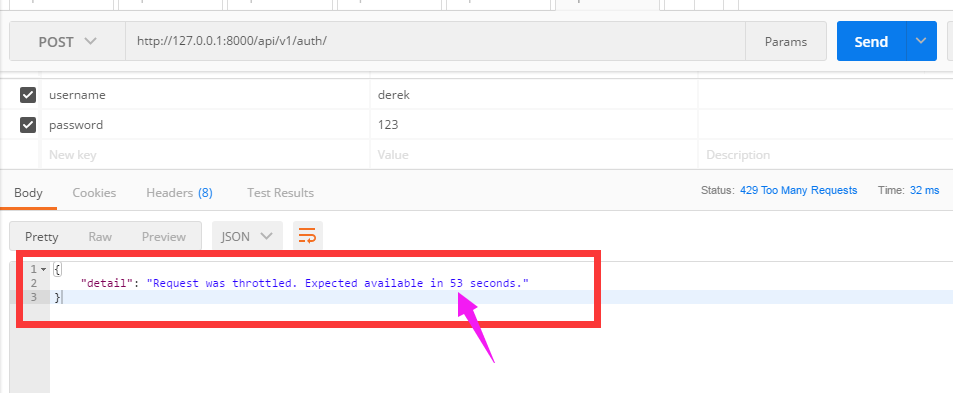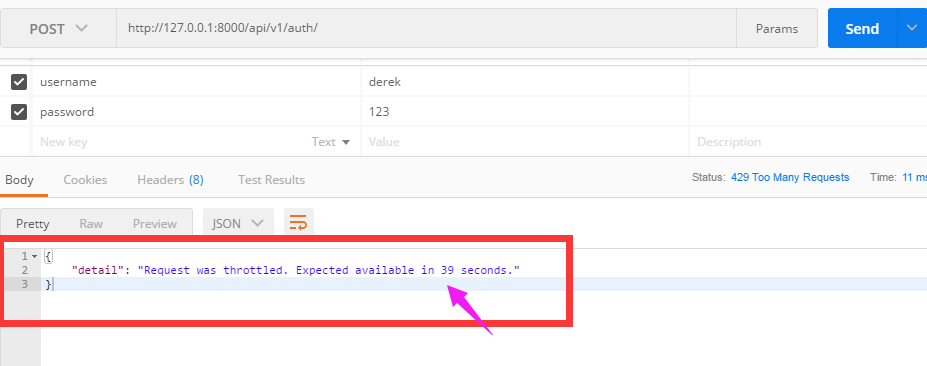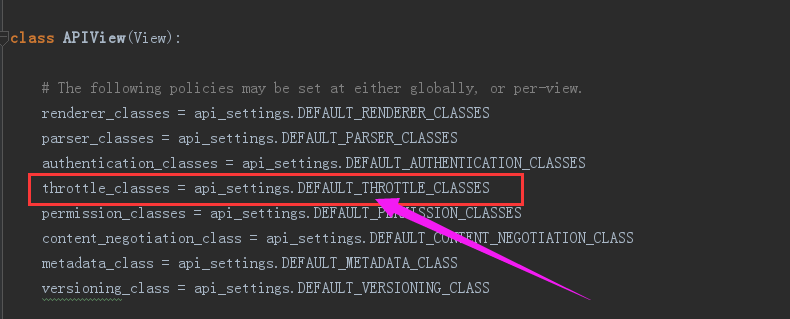Django rest framework源码分析(3)----节流
一 添加节流
自定义节流的方法
- 限制60s内只能访问3次
(1)API文件夹下面新建throttle.py,代码如下:
1 2 3 4 5 6 7 8 9 10 11 12 13 14 15 16 17 18 19 20 21 22 23 24 25 26 27 28 29 30 31 32 33 34 35 36 37 | # utils/throttle.pyfrom rest_framework.throttling import BaseThrottleimport timeVISIT_RECORD = {} #保存访问记录class VisitThrottle(BaseThrottle): '''60s内只能访问3次''' def __init__(self): self.history = None #初始化访问记录 def allow_request(self,request,view): #获取用户ip (get_ident) remote_addr = self.get_ident(request) ctime = time.time() #如果当前IP不在访问记录里面,就添加到记录 if remote_addr not in VISIT_RECORD: VISIT_RECORD[remote_addr] = [ctime,] #键值对的形式保存 return True #True表示可以访问 #获取当前ip的历史访问记录 history = VISIT_RECORD.get(remote_addr) #初始化访问记录 self.history = history #如果有历史访问记录,并且最早一次的访问记录离当前时间超过60s,就删除最早的那个访问记录, #只要为True,就一直循环删除最早的一次访问记录 while history and history[-1] < ctime - 60: history.pop() #如果访问记录不超过三次,就把当前的访问记录插到第一个位置(pop删除最后一个) if len(history) < 3: history.insert(0,ctime) return True def wait(self): '''还需要等多久才能访问''' ctime = time.time() return 60 - (ctime - self.history[-1]) |
(2)settings中全局配置节流
1 2 3 4 5 | #全局REST_FRAMEWORK = { #节流 "DEFAULT_THROTTLE_CLASSES":['API.utils.throttle.VisitThrottle'],} |
(3)现在访问auth看看结果:
- 60s内访问次数超过三次,会限制访问
- 提示剩余多少时间可以访问

接着访问

二 节流源码分析
(1)dispatch
1 2 3 4 5 6 7 8 9 10 11 12 13 14 15 16 17 18 19 20 21 22 23 24 25 26 27 28 29 30 31 32 33 34 35 36 37 38 39 40 41 | def dispatch(self, request, *args, **kwargs): """ `.dispatch()` is pretty much the same as Django's regular dispatch, but with extra hooks for startup, finalize, and exception handling. """ self.args = args self.kwargs = kwargs #对原始request进行加工,丰富了一些功能 #Request( # request, # parsers=self.get_parsers(), # authenticators=self.get_authenticators(), # negotiator=self.get_content_negotiator(), # parser_context=parser_context # ) #request(原始request,[BasicAuthentications对象,]) #获取原生request,request._request #获取认证类的对象,request.authticators #1.封装request request = self.initialize_request(request, *args, **kwargs) self.request = request self.headers = self.default_response_headers # deprecate? try: #2.认证 self.initial(request, *args, **kwargs) # Get the appropriate handler method if request.method.lower() in self.http_method_names: handler = getattr(self, request.method.lower(), self.http_method_not_allowed) else: handler = self.http_method_not_allowed response = handler(request, *args, **kwargs) except Exception as exc: response = self.handle_exception(exc) self.response = self.finalize_response(request, response, *args, **kwargs) return self.response |
(2)initial
1 2 3 4 5 6 7 8 9 10 11 12 13 14 15 16 17 18 19 20 21 | def initial(self, request, *args, **kwargs): """ Runs anything that needs to occur prior to calling the method handler. """ self.format_kwarg = self.get_format_suffix(**kwargs) # Perform content negotiation and store the accepted info on the request neg = self.perform_content_negotiation(request) request.accepted_renderer, request.accepted_media_type = neg # Determine the API version, if versioning is in use. version, scheme = self.determine_version(request, *args, **kwargs) request.version, request.versioning_scheme = version, scheme # Ensure that the incoming request is permitted #4.实现认证 self.perform_authentication(request) #5.权限判断 self.check_permissions(request) #6.控制访问频率 self.check_throttles(request) |
(3)check_throttles
里面有个allow_request
1 2 3 4 5 6 7 8 | def check_throttles(self, request): """ Check if request should be throttled. Raises an appropriate exception if the request is throttled. """ for throttle in self.get_throttles(): if not throttle.allow_request(request, self): self.throttled(request, throttle.wait()) |
(4)get_throttles
1 2 3 4 5 | def get_throttles(self): """ Instantiates and returns the list of throttles that this view uses. """ return [throttle() for throttle in self.throttle_classes] |
(5)thtottle_classes

三 内置节流类
上面是写的自定义节流,drf内置了很多节流的类,用起来比较方便。
(1)BaseThrottle
- 自己要写allow_request和wait方法
- get_ident就是获取ip
1 2 3 4 5 6 7 8 9 10 11 12 13 14 15 16 17 18 19 20 21 22 23 24 25 26 27 28 29 30 31 32 33 34 35 36 | class BaseThrottle(object): """ Rate throttling of requests. """ def allow_request(self, request, view): """ Return `True` if the request should be allowed, `False` otherwise. """ raise NotImplementedError('.allow_request() must be overridden') def get_ident(self, request): """ Identify the machine making the request by parsing HTTP_X_FORWARDED_FOR if present and number of proxies is > 0. If not use all of HTTP_X_FORWARDED_FOR if it is available, if not use REMOTE_ADDR. """ xff = request.META.get('HTTP_X_FORWARDED_FOR') remote_addr = request.META.get('REMOTE_ADDR') num_proxies = api_settings.NUM_PROXIES if num_proxies is not None: if num_proxies == 0 or xff is None: return remote_addr addrs = xff.split(',') client_addr = addrs[-min(num_proxies, len(addrs))] return client_addr.strip() return ''.join(xff.split()) if xff else remote_addr def wait(self): """ Optionally, return a recommended number of seconds to wait before the next request. """ return None |
(2)SimpleRateThrottle
1 2 3 4 5 6 7 8 9 10 11 12 13 14 15 16 17 18 19 20 21 22 23 24 25 26 27 28 29 30 31 32 33 34 35 36 37 38 39 40 41 42 43 44 45 46 47 48 49 50 51 52 53 54 55 56 57 58 59 60 61 62 63 64 65 66 67 68 69 70 71 72 73 74 75 76 77 78 79 80 81 82 83 84 85 86 87 88 89 90 91 92 93 94 95 96 97 98 99 100 101 102 103 104 105 106 107 108 109 110 111 112 113 | class SimpleRateThrottle(BaseThrottle): """ A simple cache implementation, that only requires `.get_cache_key()` to be overridden. The rate (requests / seconds) is set by a `rate` attribute on the View class. The attribute is a string of the form 'number_of_requests/period'. Period should be one of: ('s', 'sec', 'm', 'min', 'h', 'hour', 'd', 'day') Previous request information used for throttling is stored in the cache. """ cache = default_cache timer = time.time cache_format = 'throttle_%(scope)s_%(ident)s' scope = None #这个值自定义,写什么都可以 THROTTLE_RATES = api_settings.DEFAULT_THROTTLE_RATES def __init__(self): if not getattr(self, 'rate', None): self.rate = self.get_rate() self.num_requests, self.duration = self.parse_rate(self.rate) def get_cache_key(self, request, view): """ Should return a unique cache-key which can be used for throttling. Must be overridden. May return `None` if the request should not be throttled. """ raise NotImplementedError('.get_cache_key() must be overridden') def get_rate(self): """ Determine the string representation of the allowed request rate. """ if not getattr(self, 'scope', None): msg = ("You must set either `.scope` or `.rate` for '%s' throttle" % self.__class__.__name__) raise ImproperlyConfigured(msg) try: return self.THROTTLE_RATES[self.scope] except KeyError: msg = "No default throttle rate set for '%s' scope" % self.scope raise ImproperlyConfigured(msg) def parse_rate(self, rate): """ Given the request rate string, return a two tuple of: <allowed number of requests>, <period of time in seconds> """ if rate is None: return (None, None) num, period = rate.split('/') num_requests = int(num) duration = {'s': 1, 'm': 60, 'h': 3600, 'd': 86400}[period[0]] return (num_requests, duration) def allow_request(self, request, view): """ Implement the check to see if the request should be throttled. On success calls `throttle_success`. On failure calls `throttle_failure`. """ if self.rate is None: return True self.key = self.get_cache_key(request, view) if self.key is None: return True self.history = self.cache.get(self.key, []) self.now = self.timer() # Drop any requests from the history which have now passed the # throttle duration while self.history and self.history[-1] <= self.now - self.duration: self.history.pop() if len(self.history) >= self.num_requests: return self.throttle_failure() return self.throttle_success() def throttle_success(self): """ Inserts the current request's timestamp along with the key into the cache. """ self.history.insert(0, self.now) self.cache.set(self.key, self.history, self.duration) return True def throttle_failure(self): """ Called when a request to the API has failed due to throttling. """ return False def wait(self): """ Returns the recommended next request time in seconds. """ if self.history: remaining_duration = self.duration - (self.now - self.history[-1]) else: remaining_duration = self.duration available_requests = self.num_requests - len(self.history) + 1 if available_requests <= 0: return None return remaining_duration / float(available_requests) |
我们可以通过继承SimpleRateThrottle类,来实现节流,会更加的简单,因为SimpleRateThrottle里面都帮我们写好了
(1)throttle.py
1 2 3 4 5 6 7 8 9 10 11 12 13 14 15 16 | from rest_framework.throttling import SimpleRateThrottleclass VisitThrottle(SimpleRateThrottle): '''匿名用户60s只能访问三次(根据ip)''' scope = 'NBA' #这里面的值,自己随便定义,settings里面根据这个值配置Rate def get_cache_key(self, request, view): #通过ip限制节流 return self.get_ident(request)class UserThrottle(SimpleRateThrottle): '''登录用户60s可以访问10次''' scope = 'NBAUser' #这里面的值,自己随便定义,settings里面根据这个值配置Rate def get_cache_key(self, request, view): return request.user.username |
(2)settings.py
1 2 3 4 5 6 7 8 9 | #全局REST_FRAMEWORK = { #节流 "DEFAULT_THROTTLE_CLASSES":['API.utils.throttle.UserThrottle'], #全局配置,登录用户节流限制(10/m) "DEFAULT_THROTTLE_RATES":{ 'NBA':'3/m', #没登录用户3/m,NBA就是scope定义的值 'NBAUser':'10/m', #登录用户10/m,NBAUser就是scope定义的值 }} |
(3)views.py
局部配置方法
1 2 3 4 5 6 7 8 | class AuthView(APIView): . . . # 默认的节流是登录用户(10/m),AuthView不需要登录,这里用匿名用户的节流(3/m) throttle_classes = [VisitThrottle,] . . |

from django.shortcuts import render,HttpResponse from django.http import JsonResponse from rest_framework.views import APIView from API import models from rest_framework.request import Request from rest_framework import exceptions from rest_framework.authentication import BaseAuthentication from API.utils.permission import SVIPPremission,MyPremission from API.utils.throttle import VisitThrottle ORDER_DICT = { 1:{ 'name':'apple', 'price':15 }, 2:{ 'name':'dog', 'price':100 } } def md5(user): import hashlib import time #当前时间,相当于生成一个随机的字符串 ctime = str(time.time()) m = hashlib.md5(bytes(user,encoding='utf-8')) m.update(bytes(ctime,encoding='utf-8')) return m.hexdigest() class AuthView(APIView): '''用于用户登录验证''' authentication_classes = [] #里面为空,代表不需要认证 permission_classes = [] #不里面为空,代表不需要权限 # 默认的节流是登录用户(10/m),AuthView不需要登录,这里用匿名用户的节流(3/m) throttle_classes = [VisitThrottle,] def post(self,request,*args,**kwargs): ret = {'code':1000,'msg':None} try: user = request._request.POST.get('username') pwd = request._request.POST.get('password') obj = models.UserInfo.objects.filter(username=user,password=pwd).first() if not obj: ret['code'] = 1001 ret['msg'] = '用户名或密码错误' #为用户创建token token = md5(user) #存在就更新,不存在就创建 models.UserToken.objects.update_or_create(user=obj,defaults={'token':token}) ret['token'] = token except Exception as e: ret['code'] = 1002 ret['msg'] = '请求异常' return JsonResponse(ret) class OrderView(APIView): ''' 订单相关业务(只有SVIP用户才能看) ''' def get(self,request,*args,**kwargs): self.dispatch #request.user #request.auth ret = {'code':1000,'msg':None,'data':None} try: ret['data'] = ORDER_DICT except Exception as e: pass return JsonResponse(ret) class UserInfoView(APIView): ''' 订单相关业务(普通用户和VIP用户可以看) ''' permission_classes = [MyPremission,] #不用全局的权限配置的话,这里就要写自己的局部权限 def get(self,request,*args,**kwargs): print(request.user) return HttpResponse('用户信息') views.py
说明:
- API.utils.throttle.UserThrottle 这个是全局配置(根据ip限制,10/m)
- DEFAULT_THROTTLE_RATES --->>>设置访问频率的
- throttle_classes = [VisitThrottle,] --->>>局部配置(不适用settings里面默认的全局配置)
总结
基本使用
- 创建类,继承BaseThrottle, 实现:allow_request ,wait
- 创建类,继承SimpleRateThrottle, 实现: get_cache_key, scope='NBA' (配置文件中的key)
全局
1 2 3 4 5 6 7 | #节流 "DEFAULT_THROTTLE_CLASSES":['API.utils.throttle.UserThrottle'], #全局配置,登录用户节流限制(10/m) "DEFAULT_THROTTLE_RATES":{ 'NBA':'3/m', #没登录用户3/m,NBA就是scope定义的值 'NBAUser':'10/m', #登录用户10/m,NBAUser就是scope定义的值 }} |
局部
1 | throttle_classes = [VisitThrottle,] |
所有代码
认证、权限和节流

# MyProject/urls.py from django.contrib import admin from django.urls import path from API.views import AuthView,OrderView,UserInfoView urlpatterns = [ path('admin/', admin.site.urls), path('api/v1/auth/',AuthView.as_view()), path('api/v1/order/',OrderView.as_view()), path('api/v1/info/',UserInfoView.as_view()), ]

#全局 REST_FRAMEWORK = { #认证 "DEFAULT_AUTHENTICATION_CLASSES":['API.utils.auth.Authentication',], #权限 "DEFAULT_PERMISSION_CLASSES":['API.utils.permission.SVIPPermission'], #节流 "DEFAULT_THROTTLE_CLASSES":['API.utils.throttle.UserThrottle'], #全局配置,登录用户节流限制(10/m) "DEFAULT_THROTTLE_RATES":{ 'NBA':'3/m', #没登录用户3/m,NBA就是scope定义的值 'NBAUser':'10/m', #登录用户10/m,NBAUser就是scope定义的值 } }

# API/models.py from django.db import models class UserInfo(models.Model): USER_TYPE = ( (1,'普通用户'), (2,'VIP'), (3,'SVIP') ) user_type = models.IntegerField(choices=USER_TYPE) username = models.CharField(max_length=32) password = models.CharField(max_length=64) class UserToken(models.Model): user = models.OneToOneField(UserInfo,on_delete=models.CASCADE) token = models.CharField(max_length=64)

# API/views.py from django.shortcuts import render,HttpResponse from django.http import JsonResponse from rest_framework.views import APIView from API import models from rest_framework.request import Request from rest_framework import exceptions from rest_framework.authentication import BaseAuthentication from API.utils.permission import SVIPPermission,MyPermission from API.utils.throttle import VisitThrottle ORDER_DICT = { 1:{ 'name':'apple', 'price':15 }, 2:{ 'name':'dog', 'price':100 } } def md5(user): import hashlib import time #当前时间,相当于生成一个随机的字符串 ctime = str(time.time()) m = hashlib.md5(bytes(user,encoding='utf-8')) m.update(bytes(ctime,encoding='utf-8')) return m.hexdigest() class AuthView(APIView): '''用于用户登录验证''' authentication_classes = [] #里面为空,代表不需要认证 permission_classes = [] #不里面为空,代表不需要权限 # 默认的节流是登录用户(10/m),AuthView不需要登录,这里用匿名用户的节流(3/m) throttle_classes = [VisitThrottle,] def post(self,request,*args,**kwargs): ret = {'code':1000,'msg':None} try: user = request._request.POST.get('username') pwd = request._request.POST.get('password') obj = models.UserInfo.objects.filter(username=user,password=pwd).first() if not obj: ret['code'] = 1001 ret['msg'] = '用户名或密码错误' #为用户创建token token = md5(user) #存在就更新,不存在就创建 models.UserToken.objects.update_or_create(user=obj,defaults={'token':token}) ret['token'] = token except Exception as e: ret['code'] = 1002 ret['msg'] = '请求异常' return JsonResponse(ret) class OrderView(APIView): ''' 订单相关业务(只有SVIP用户才能看) ''' def get(self,request,*args,**kwargs): self.dispatch #request.user #request.auth ret = {'code':1000,'msg':None,'data':None} try: ret['data'] = ORDER_DICT except Exception as e: pass return JsonResponse(ret) class UserInfoView(APIView): ''' 订单相关业务(普通用户和VIP用户可以看) ''' permission_classes = [MyPermission,] #不用全局的权限配置的话,这里就要写自己的局部权限 def get(self,request,*args,**kwargs): print(request.user) return HttpResponse('用户信息')

# API/utils/auth/py from rest_framework import exceptions from API import models from rest_framework.authentication import BaseAuthentication class Authentication(BaseAuthentication): '''用于用户登录验证''' def authenticate(self,request): token = request._request.GET.get('token') token_obj = models.UserToken.objects.filter(token=token).first() if not token_obj: raise exceptions.AuthenticationFailed('用户认证失败') #在rest framework内部会将这两个字段赋值给request,以供后续操作使用 return (token_obj.user,token_obj) def authenticate_header(self, request): pass

# utils/permission.py from rest_framework.permissions import BasePermission class SVIPPermission(BasePermission): message = "必须是SVIP才能访问" def has_permission(self,request,view): if request.user.user_type != 3: return False return True class MyPermission(BasePermission): def has_permission(self,request,view): if request.user.user_type == 3: return False return True

# utils/throttle.py # # from rest_framework.throttling import BaseThrottle # import time # VISIT_RECORD = {} #保存访问记录 # # class VisitThrottle(BaseThrottle): # '''60s内只能访问3次''' # def __init__(self): # self.history = None #初始化访问记录 # # def allow_request(self,request,view): # #获取用户ip (get_ident) # remote_addr = self.get_ident(request) # ctime = time.time() # #如果当前IP不在访问记录里面,就添加到记录 # if remote_addr not in VISIT_RECORD: # VISIT_RECORD[remote_addr] = [ctime,] #键值对的形式保存 # return True #True表示可以访问 # #获取当前ip的历史访问记录 # history = VISIT_RECORD.get(remote_addr) # #初始化访问记录 # self.history = history # # #如果有历史访问记录,并且最早一次的访问记录离当前时间超过60s,就删除最早的那个访问记录, # #只要为True,就一直循环删除最早的一次访问记录 # while history and history[-1] < ctime - 60: # history.pop() # #如果访问记录不超过三次,就把当前的访问记录插到第一个位置(pop删除最后一个) # if len(history) < 3: # history.insert(0,ctime) # return True # # def wait(self): # '''还需要等多久才能访问''' # ctime = time.time() # return 60 - (ctime - self.history[-1]) from rest_framework.throttling import SimpleRateThrottle class VisitThrottle(SimpleRateThrottle): '''匿名用户60s只能访问三次(根据ip)''' scope = 'NBA' #这里面的值,自己随便定义,settings里面根据这个值配置Rate def get_cache_key(self, request, view): #通过ip限制节流 return self.get_ident(request) class UserThrottle(SimpleRateThrottle): '''登录用户60s可以访问10次''' scope = 'NBAUser' #这里面的值,自己随便定义,settings里面根据这个值配置Rate def get_cache_key(self, request, view): return request.user.username
生活不会突变,你要做的只是耐心和积累。人这一辈子没法做太多的事情,所以每一件都要做得精彩绝伦。你的时间有限,做喜欢的事情会令人愉悦,所以跟随自己的本心。




【推荐】还在用 ECharts 开发大屏?试试这款永久免费的开源 BI 工具!
【推荐】国内首个AI IDE,深度理解中文开发场景,立即下载体验Trae
【推荐】编程新体验,更懂你的AI,立即体验豆包MarsCode编程助手
【推荐】轻量又高性能的 SSH 工具 IShell:AI 加持,快人一步
· .NET 原生驾驭 AI 新基建实战系列:向量数据库的应用与畅想
· 从问题排查到源码分析:ActiveMQ消费端频繁日志刷屏的秘密
· 一次Java后端服务间歇性响应慢的问题排查记录
· dotnet 源代码生成器分析器入门
· ASP.NET Core 模型验证消息的本地化新姿势
· 从零开始开发一个 MCP Server!
· ThreeJs-16智慧城市项目(重磅以及未来发展ai)
· .NET 原生驾驭 AI 新基建实战系列(一):向量数据库的应用与畅想
· Ai满嘴顺口溜,想考研?浪费我几个小时
· Browser-use 详细介绍&使用文档